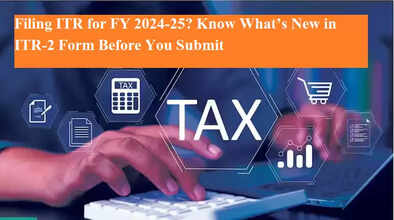Filing ITR for FY 2024-25? Know What’s New in ITR-2 Form Before You Submit

If you're planning to file your Income Tax Return (ITR) this year and fall under the category of salaried individuals, investors in cryptocurrencies, or have capital gains or non-business income, then the ITR-2 form is likely the one you'll be using. The Income Tax Department has released the updated Excel utilities for ITR-2 and ITR-3, along with previously available ITR-1 and ITR-4. But before you go ahead and file, make sure you're aware of the changes made to ITR-2 for Assessment Year 2025–26.
Here’s a breakdown of the major updates in the ITR-2 form, including what they mean for taxpayers and how they could impact your filing.
Who Should Use ITR-2?
The ITR-2 form is intended for individuals and Hindu Undivided Families (HUFs) who do not have income from business or profession. It is suitable for those with:
-
Salary or pension income
-
Capital gains (short-term or long-term)
-
Income from more than one house property
-
Foreign assets or foreign income
-
Income from crypto or digital assets
-
Dividend income and more
If you fall into one or more of these categories, you’re expected to file your return using the updated ITR-2 form.
What’s New in ITR-2 for AY 2025–26?
1. Reporting of Capital Loss from Share Buybacks
A new row has been introduced for taxpayers to report capital losses arising from share buybacks. This applies in cases where dividend income is declared under "Income from Other Sources." The provision allows such losses to be adjusted under the capital gains section.
2. New Disclosure Row for Dividend Income (Section 2(22)(f))
If you’ve earned dividend income from share buybacks, you are now required to declare it separately under a newly added field referencing Section 2(22)(f). This aims to improve clarity in dividend taxation and prevent misreporting.
3. Property Transfer Details
Individuals who have sold or transferred land or building before or after July 23, 2024, will now need to provide detailed information on the cost of acquisition and improvement. This change ensures proper application of indexation benefits during capital gains computation.
4. Enhanced Asset and Liability Reporting Threshold
If your total income exceeds ₹1 crore, you must now declare your complete list of assets and liabilities. Earlier, this reporting was mandatory only for incomes above ₹50 lakh. This includes bank balances, investments, vehicles, and immovable properties.
5. Revised Capital Gains Reporting Format
In line with amendments made through the Finance Act 2024, the ITR-2 form now reflects updated structures for reporting capital gains. This includes clearer segregation of different asset types and holding periods to avoid calculation errors.
6. TDS Schedule Updates
A new column has been added to the TDS (Tax Deducted at Source) schedule, where taxpayers are required to specify the nature of income under which TDS has been deducted. This improves cross-verification with Form 26AS and AIS data.
Why These Changes Matter
These modifications are aimed at enhancing transparency, minimizing errors, and aligning tax reporting with evolving income types, such as cryptocurrency and complex capital market investments. With tax laws evolving rapidly, these changes help the department better assess actual income and tax liabilities.
Filing Utility and Deadline Extension
The updated Excel utilities for ITR-2 are now available for download on the official e-filing portal (https://www.incometax.gov.in). Owing to significant changes in ITR forms, the Income Tax Department has also extended the ITR filing deadline, giving taxpayers more time to review and file accurately.
Final Thoughts
If you're using ITR-2 for AY 2025–26, it’s essential to carefully review these changes before proceeding. Whether you're a salaried employee with capital gains or an investor dealing in digital assets, this updated form ensures your income is reported correctly — but only if you understand and apply the new requirements properly.
Staying informed about these updates can help you avoid notices, rejections, or penalties — and ensures a smooth, compliant filing experience this tax season.

